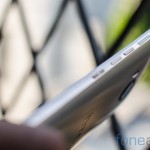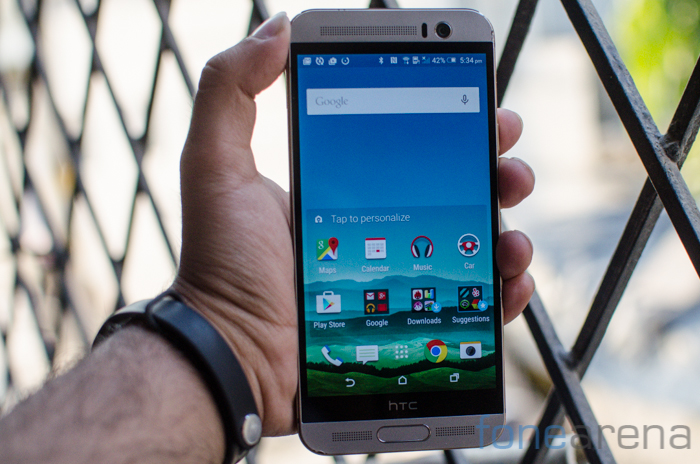
One of the old ones, HTC remains as one of the few smartphone manufacturers that have been able to stand the test of time. Brand loyalty and genuinely well built, pioneering products that consumers want have guaranteed that so far. When the HTC One launched, it was widely regarded as the best phone around. Fast forward an year and HTC mixed it up yet again with the One M8 that brought along a somewhat gimmicky depth sensor but pushed the design and build further ahead. But if the recent financial reports and consumer sentiment are anything to go by, it seems that HTC is running out of steam. The recent release of the One M9+ has a lot riding on it’s shoulders. Is it good enough to stem the tide and bring new consumers into the fold? We find out in our review.
Design
Design has always been HTC’s forte. Comparable to the likes of Apple, the company has pushed the barriers of hardware design and quality resulting in improvements across Android devices as a collective whole. The use of metal, attention to detail didn’t go unnoticed with the consumers either. With the One M9+ though, there’s a lot of mixed emotions. While the handset is visually appealing, at first glance it is strikingly similar to the model it replaces. Take a closer look though and you’ll notice a fair few changes. We’re not sure we approve of all of them though.

The front of the phone has a large 5.2 inch display that is surrounded by a fairly large bezel.The bezel gets larger still above and below the display where an HTC logo is placed. Above and below the display are also the BoomSound speakers that HTC is famous for. The speaker grille at the bottom is split in two to make space for the fingerprint reader while the one at the top doesn’t extend all the way through to make way for the front facing camera and proximity sensor. All in all, the design is starting to get a bit long in the tooth and we really hope that HTC thinks out of the box for their next flagship.
Compared to the unibody design of the One M8, there’s one major change here that we’re very tempted to term as a flaw. Where the previous model flowed around the edges, the One M9+ makes your fingers come to a jarring halt. The front and back halves of the phone seem like two distinct entities stuck together. The prominent ridge running around the front of the phone is irksome to say the least and stands out as a break in the beautiful curves of the metal body. The microSD and nano SIM card slot are placed on either side of the handset. The right side sports the machined aluminum volume buttons as well as the power key that is placed within easy reach of your hand. The 3.5mm audio jack and charging connector are at the bottom while the top has a wide black plastic strip that hides away the iR port.
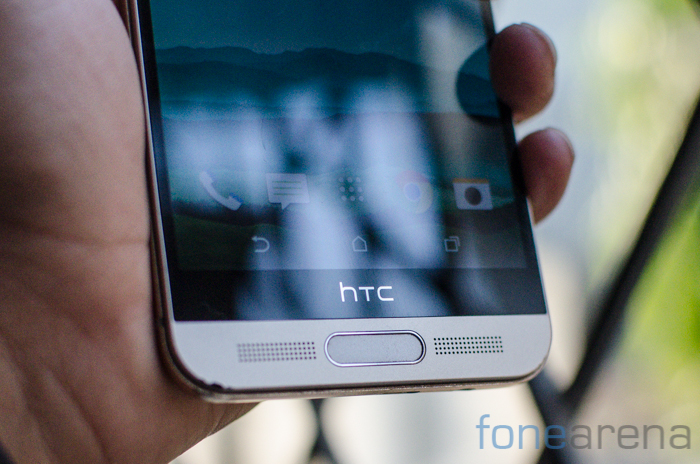
HTC has experimented with fingerprint sensors before. They were a disaster. This time around, there’s a plethora of improvements that make the software half tolerable. The hardware though, that’s still to be sorted out. The horizontally aligned oval fingerprint reader isn’t the most conducive to scanning the entire fingerprint at a time. First time set up is a laborious process and involves a lot of frustrated finger placing. Once done, you’d expect to forget about it altogether but the fingerprint scanner fails to read your print enough times for it to become irksome. A marked improvement over the likes of the One Max, theres still a bit of work needed to be done to make scanning the seamless process it should be. Thankfully the button is also mapped out as the home key as we instinctively kept pressing the button while using the handset. A bit subjective but worth noting is that the placement of the key isn’t particularly ergonomic. We felt that the phone would slip out from our hands while tying to tap the button. Your mileage may vary though.
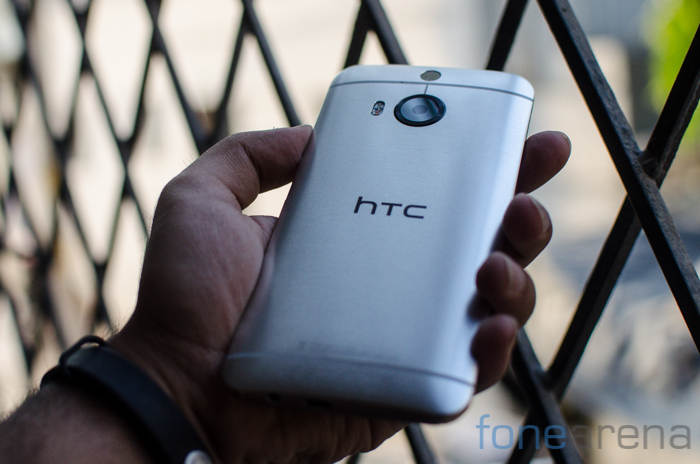
The HTC One M9+ has a sexy back. The gorgeous curved metal has been polished to a sheen and looks absolutely stunning. The phone is also very comfortable to hold with the curved metal fitting in with the contours of your hand. The phone is also extremely slippery. We found ourselves catching the phone at least thrice in our review period which is three times more than i’d want to risk. The M9+ measures 151 x 72 x 9.6 mm and weighs a somewhat hefty 168grams. This is a tank of a phone, well built with a nice albeit boring design. The key problem really is that the competition hasn’t just caught but has exceeded HTC in the very parameters where they excelled. But for now, let’s talk about the software side of things.
Software
Running on Android 5.0 with Sense UI 7.0 on board, there’s not much that has changed software wise. You have the same two way split homescreen where swiping all the way to the left brings out BlinkFeed. The other panels are standard HTC and let you place widgets or app shortcuts as you please.
Dive into the app drawer and you’ll spot a long list of scrollable app icons. You’ll notice the trend around the entirety of the handset wherein it appears mostly unremarkable. The only minor noticeable addition is that of a home-screen widget that adds and arranges apps based on your location. There’s also a themes app but you’re probably better off installing a third party launcher.
Performance
The HTC One M9+ is a top of the line flagship device powered by a MediaTek chipset. Let that sink in for a while. A MediaTek chipset in a flagship product is unheard of and signifies a landmark change in the processor manufacturer’s standing as well. MediaTek has so far been known only as a supplier of efficient, low cost chipsets for entry level and mid range products. The particular chipset being used in the One M9+ is the MediaTek 6795T also known as the Helio X10. This is a Full 64-bit octa-core CPU with clock speeds up to 2.2GHz and has been paired with 3GB of RAM. Free RAM hovers around 1300MB after an hour or so of idling, at fresh boot there’s around 1500MB of free RAM. In real world usage, the phone remains slick and smooth throughout the interface and even while playing resource intensive games. Indeed the phone is unremarkable in the fact that there’s nothing negative to report regarding the performance of the handset. Benchmark numbers do disappoint a bit but they’re not the be all and end all. The numbers put performance of the Helio X10 chipset somewhere below the Snapdragon 810 and the Exynos 7 Octa but suffice it to say that we never found the M9+ trying to catch it’s breath.
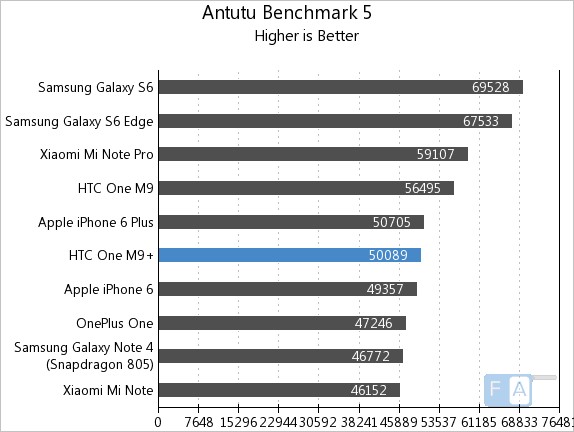
AnTuTu is an all encompassing benchmark wherein the handset scores 50089 points. This places it significantly behind the likes of the S6 Edge and the Galaxy S6 which have 67533 and 69528 points respectively.
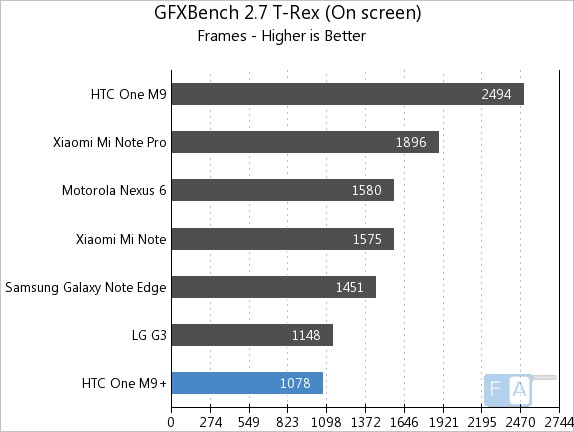
In the GPU centric GFXBench test, the One M9+ scores just 1078 points. This shows the underlying problem with the PowerVR G6200 graphic cores and highlights how it lags behind the Snapdragon 810 toting competition. While it wasn’t quite apparent during gaming or daily usage, we feel it could prove to be a hassle over time.
Display
HTC has famously stuck to 1080p panels on their handsets for a really long time and for good reason. The advantages are minimal with bumping up the resolution and there’s a fair bit of battery drain as well. But competition dictates the market and HTC has also advanced to a 2K panel on the One M9+. The 5.2 inch display is of the Super LCD3 variety in contrast to the AMOLED panels widely used by Samsung.

While the resolution might be high enough to compete with the competition, the quality of the panel isn’t. The whites aren’t overtly white and pink hues can be spotted at certain angles. Other than that though, the contrast ratio is nice and the viewing angles are decent. This is a perfectly serviceable display but it won’t wow you like the panels on the Samsung Galaxy S6 / S6 Edge or for that matter even the LG G4.
Camera
With the HTC One M7, the company pioneered UltraPixels. Lower resolution but larger pixel size means that you get brighter and better images, at least on paper. The end results were a mixed bag. With the One M8, you got a gimmick in the form of a duo camera that combined the UltraPixel camera of the M7 with a secondary camera that could capture depth info and let you manipulate the depth of field. Performance here too was middling.
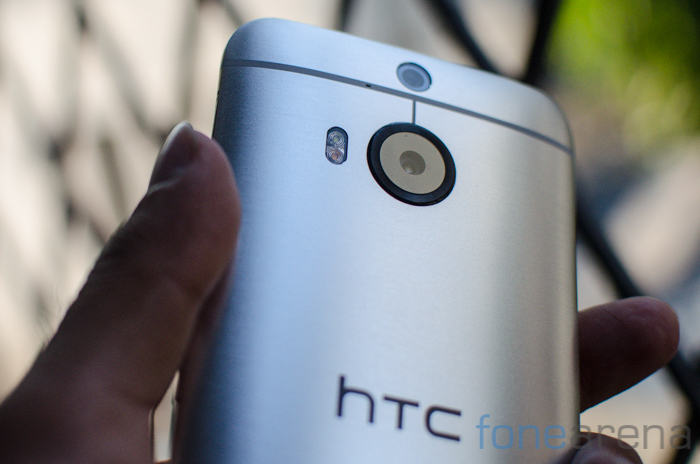
With the M9+, you get the whole host of gimmicks next to a high resolution camera and HTC’s software powering the show. Over at the back is a 20MP camera with a dual tone LED flash next to it. There’s another 2.1MP depth sensing camera above it. The UltraPixel camera is at the front and has a resolution of 4MP and a 1/3″ sensor size.

To cut the long story short, the camera isn’t particularly special and certainly doesn’t compete with the Samsung or LG competition. It takes passable shots in good lighting. 1:1 inspection reveals that the greens are mostly smudged out in foliage. Noise control is quite aggressive as well.
(Full resolution – Sample 1, Sample 2, Sample 3, Sample 4, Sample 5, Sample 6)
Other than the gimmicky method of changing the depth of field, you can also use it to add a range of software based effects and cut aways that honestly speaking, you’ll never use. The white balance is prone to being off as can be noticed in the central image. The camera also has a tendency to overblow highlights drastically. The real shocker however is low light photography where the phone is practically unusable. The camera is far from the selling point of the HTC One M9+ in our opinion.
Battery Life & Connectivity
The HTC One M9+ is well endowed when it comes to connectivity options. All the way from Wi-Fi b/g/n/ac, Bluetooth 4.1, Infrared, GPS, GLONASS, NFC and even FM radio; there’s practically nothing that’s missing here. Yes, you also get a microSD card to expand the 32GB of built in storage. Free storage at first boot is around 23GB. There’s USB OTG support built into the handset.
Battery life is quite a downer on the One M9+. The 2840mAh unit is far from sufficient for a full day of active usage. Active usage of social media or just media playback results in a steady loss of charge but it is gaming that truly depletes battery life in a hurry. In the best case scenario we managed to get a little over 10 hours of usage from the handset. We did not use the Ultra Power Saving mode which would cut off most connectivity and effectively turn the device into a feature phone.
Conclusion
The HTC One M9+ comes off as a lesson in mediocrity. Sure the build is nice but it has also become quite boring. The double ridge design in fact makes it come off as a bit of a hack job. The camera is once again uncompetitive which is typical HTC.
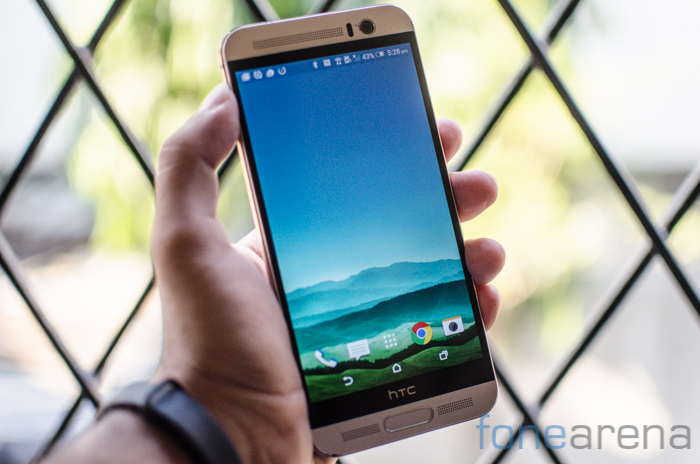
Day to day performance was good enough but hardly deserving the sky high price tag that the phone commands. Put them all together and there’s little reason for a prospective user to consider the HTC One M9+. Face it, with incremental improvements in performance, a mediocre camera at best and the lack of a fresh design perspective, there’s little incentive for the average customer to upgrade to this handset. With a price tag of Rs. 52,250, we feel that the HTC One M9+ has priced itself out of the market.
Pros
- Build quality
- 2K display
Cons
- Camera
- Battery life



